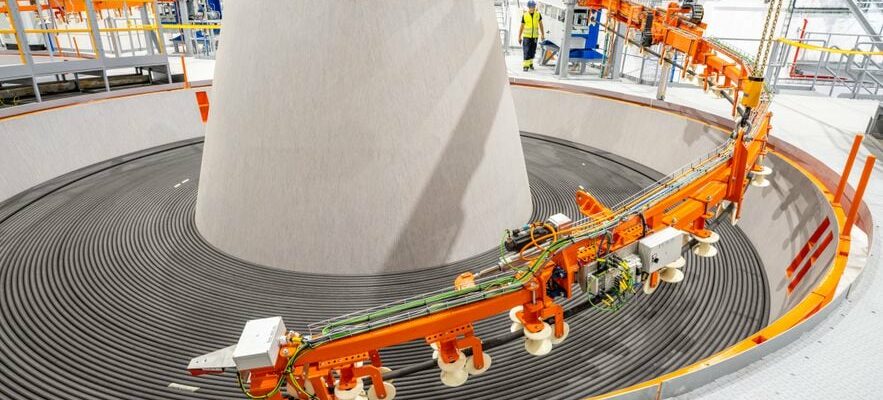The anecdote could appear in the little book of useless knowledge. Which company owns the two largest towers in Norway? The French Nexans (formerly Alcatel Cables). Cock-a-doodle Doo ! 153 meters for the highest, construction of which was recently completed. Which makes it the first skyscraper in the Nordic country, boasts the electric cable giant. It relegates to second place its elder, an almost similar copy seen from the outside, around thirty meters less, which until then reigned alone over the surroundings of Halden, not far from the Swedish border, a hundred kilometers south of Oslo. In these gray shells erected between fjord and forests, no office, floor or conference room. Emptiness, or almost. Only a laboratory at the top and two pipes, one up and one down, containing the same electrical cable on which three layers of insulating polymers are affixed. These extrusion towers are essential in the manufacture of a submarine cable in order to guarantee the protection of the conductive part, and therefore the good quality of this passer of tens of thousands of volts.
To decarbonize the economy and fight climate change, the planet must electrify. “We are entering an era worthy of the Thirty Glorious Years. We must rethink and rebuild all the electrical networks. What happened to telecommunications, with more than a million kilometers of optical fiber in the seabed, reproduces for energy. In this area, we are building the equivalent of the Internet,” summarizes Christopher Guérin, CEO of Nexans.
The French company dreams of becoming the world number 1 in electrification, with a particular specialization in high-voltage submarine cables, essential for connecting offshore wind farms or for connecting the electricity networks of two nations. The company is giving itself the means to achieve its ambitions, with the 34,000 square meter extension of its Norwegian factory, costing 290 million euros, and the investment of 300 million euros in a new cable ship – its third -, which should be operational in 2026.
“They can afford to choose their customers”
The group has, in addition to Halden, two other factories in Charleston (United States) and Tokyo Bay (Japan). But the doubling of the production capacities of its historic factory is welcome, as tensions have increased in recent years over the supply of cables. Nexans, the Italian Prysmian and the Danish NKT, the leaders in the sector, represent between 70 and 80% of the global market. The three cable companies combined had, in 2019, an order book of around 5 billion euros. “Today, it’s 33 billion,” points out Christopher Guérin. The volume of production is increasing, but less quickly than demand. Result: deadlines lengthen. “We are full until 2028”, notes Vincent Dessale, the operations director of Nexans, who has already recorded orders worth 7 billion euros, “98% for submarine projects”.
“We are now signing contracts for projects delivered after 2030. The relationship with these cable companies, which were suffering before 2020, has completely changed. They can now afford to choose their customers,” notes Gilles Etheimer, purchasing director at RTE, the manager of the French electricity network. An opportunity for a few Chinese players who are knocking on the door, hoping to compete with European champions? “We are not very open,” continues Gilles Etheimer. “There is still a technical and know-how gap, but we will quickly see them arrive,” warns Vincent Dessale, at Nexans.
At its high-voltage submarine cable factory in Halden, Norway, French company Nexans can produce cables up to 150 kilometers long and weighing almost 10,000 tonnes.
© / Nexans
In order to maintain the advantage, the French have set a clear course: do better with less. No more diversification. The company made a drastic selection during Covid-19: it now focuses on four sectors of activity, instead of 34, while having reduced its client portfolio from 17,000 to 4,000. A strategic vision narrowed around the “electrification of the world”, including the vein of submarine cables.
In the Norwegian factory in Halden, which has integrated new production technologies, they are manufactured following a meticulous process. The copper and aluminum coils are continuously hollowed out while a machine entangles the wires to the desired dimensions to form a conductor. As it progresses serpentine through the immense hangar, the cable-to-be is covered with numerous layers of insulation. Manufacturing takes several weeks and the cable, a single section of which can measure up to 150 kilometers and weigh 10,000 tonnes, is then stored on a huge table that can support the weight of the Eiffel Tower. It is up to the imposing cable ships, which can access the factory docks thanks to the deep waters of the fjord, to lay, join or repair them on the seabed.
These links are as invisible as they are essential. Nexans alone has more than 443 submarine interconnection projects, representing more than 10,000 kilometers of cables – the distance between Paris and Manila (Philippines). A threshold which will quickly be exceeded when the company has delivered, by 2026, the Celtic Interconnector, this colossal project which must link the French and Irish electricity networks thanks to a 500 kilometer underwater connection. The cable giant has also connected 42 wind farms to land offshore, including that of Saint-Brieuc. He will soon take care of those in Dieppe Le Tréport and… New York. “The city will be supplied with green energy thanks to us,” says Christopher Guérin. Double cocorico!
.
